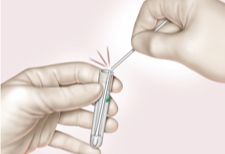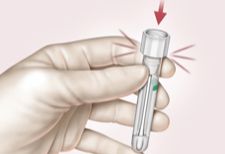Fetal fibronectin (fFN) testing can help you manage patients presenting with symptoms of preterm birth. The Rapid fFN® test returns either a positive or negative result, enabling you to manage care for your patients accordingly.1
In-Service Presentation
For new nurses and residents, or just for a refresher, a recorded Rapid fFN in-service presentation is accessible at your convenience. The presentation is approximately 15 minutes long, and also includes a quick 5-question true/false quiz at the end, to test your knowledge.
How to collect an fFN specimen
Collect specimen prior to digital examination or manipulation of the cervix to avoid sample contamination.2

Step 1
During speculum exam, lightly
rotate swab across posterior fornix of the vagina for 10 seconds to absorb cervicovaginal secretions.

Step 2
Remove swab and immerse tip in buffer. Break the shaft at the score even with the top of the tube.

Step 3
Align the shaft with the hole inside the tube cap and push down tightly over shaft, sealing tube; ensure shaft is aligned to avoid leakage. Send fetal fibronectin sample to a lab near you.
For accurate results, be sure to follow these instructions and see package insert:
- The specimen should be collected prior to a digital cervical exam, collection of culture specimens or vaginal probe ultrasound exams.
- Do not contaminate the swab or specimen with lubricants, soaps, disinfectants or creams.
- Do not test if patient has moderate or gross vaginal bleeding, advanced cervical dilation (3 cm or greater), rupture of membranes or suspected or known placental abruption or placenta previa.
- If patient has had sex in the prior 24 hours:
- A negative result is still valid
- A positive result may not be valid and should be confirmed > 24 hours
Order FREE specimen collection kits, patient brochures and other materials below.
Interpreting results of the Rapid fFN test
Negative results
A negative Rapid fFN test result has a reliably high negative predictive value (NPV) which may help rule out imminent preterm birth.
NPV for delivery within:
7 days = 99.5%
14 days = 99.2%
Less than 37 weeks = 84.5%
A negative Rapid fFN test result offers benefits that include the opportunity to better manage resources and optimize the administration of steroids.
Positive results
A positive Rapid fFN test result suggests that some type of disruption is occurring with the pregnancy. While only 13% of patients with positive Rapid fFN test result will deliver in the next seven days, almost half will deliver before 37 weeks.1
PPV for delivery within:
7 days = 12.7%
14 days = 16.7%
Less than 37 weeks = 44.7%
A positive Rapid fFN test result needs to be interpreted in consideration with other factors such as clinical assessment, medical history, and cervical length.
Interpreting results in asymptomatic patients
The Rapid fFN test is also indicated for use in asymptomatic patients during routine prenatal visits between 22 and 30 weeks of gestation in women with a singleton gestation.1
In studies on asymptomatic patients:
- NPVs ranged from 96.4% – 97.9% depending on the gestational week of collection, making it highly likely that delivery will not occur before 34 weeks of gestation.1
- PPVs ranged from 13.3% – 31.7% and represented an approximate 4- to 7-fold increase in risk over the reliability of predicting delivery in the absence of fFN testing information.1
- NPVs and PPVs varied depending on gestational week collected (24, 26, 28 & 30 weeks) and endpoint (28 or 34 weeks).1
